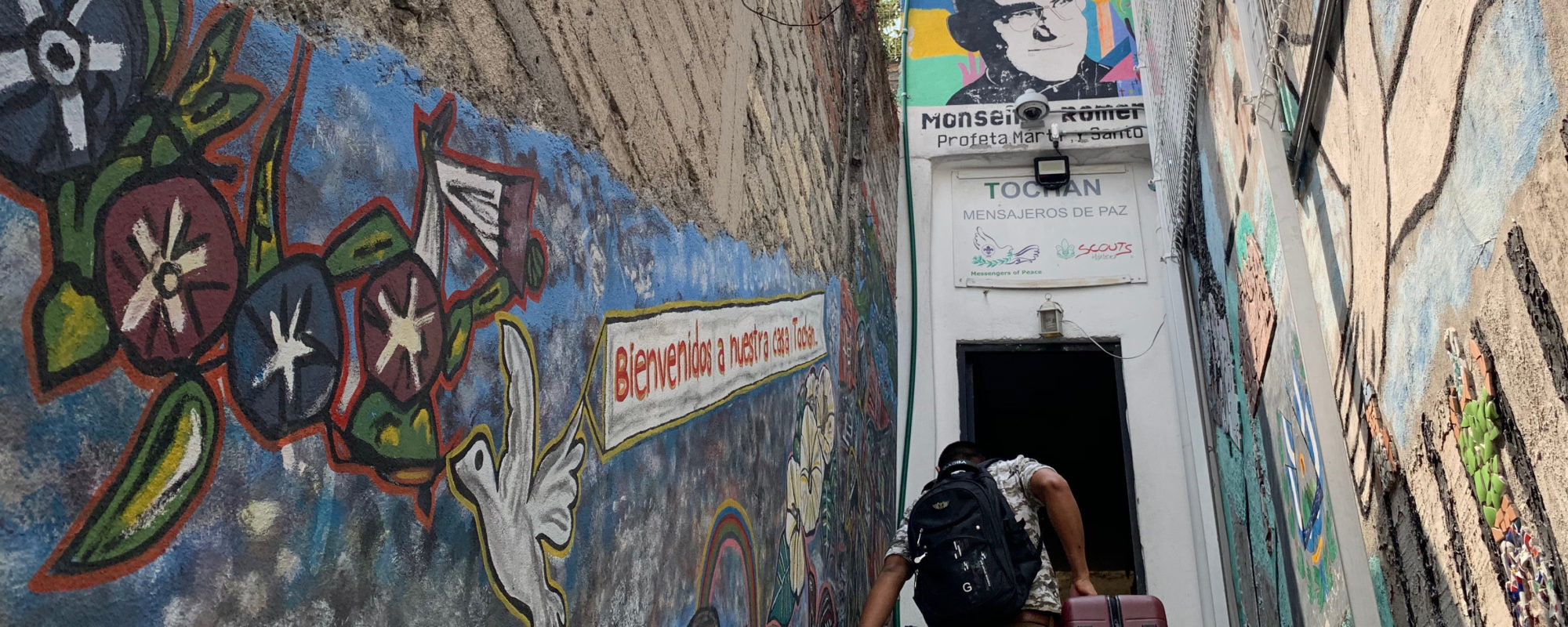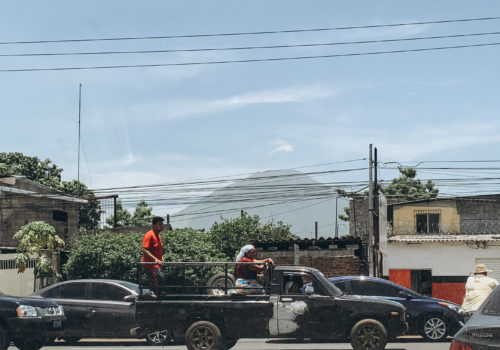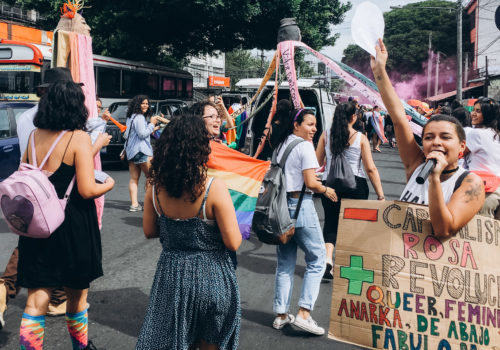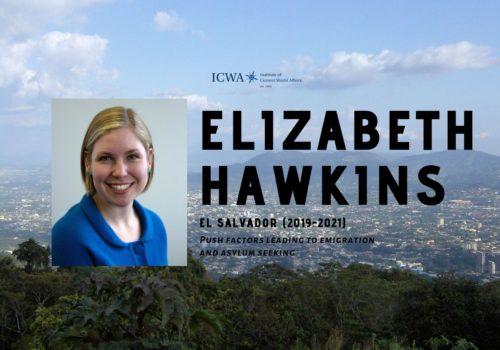MEXICO CITY — Gabriel left El Salvador with $86 in his pocket. If he had waited just one more week, he would have had another $150 from a community savings pool Mexicans call a tanda. The tall, fresh-faced young man with an easy smile has been enthusiastically telling me his story for about an hour, at a little café near Mexico City’s main square (the Zócalo), but this trips him up. He’s frustrated that now, two years later, he can’t remember the Salvadoran word.
“I know what a tanda is,” I say, trying to be helpful. I learned the concept representing immigrant women at a domestic violence shelter in the United States; how they pool their funds, then take turns spending some for legal fees. Gabriel (not his real name) shakes his head: That’s not the point. It bothers him that he’s losing the language of his home. He racks his brain for a couple more seconds then flashes his wide smile, revealing silver fillings on his back teeth, and continues with his story.
It just wasn’t worth it to wait for the money, he says. It was now or never. He didn’t tell his mother he was leaving until the morning of his departure. When she began to cry, he asked, “Please wait until I’m gone to do that, or I might lose my nerve.”
“Did she know why you were going?” I ask. It’s the first time I’ve directly broached the question of why he migrated. It would have been my third or fourth question if he had consulted me in my office in the States, but I’m not his lawyer, just a friend of an immigrant rights activist who met Gabriel soon after his arrival in Mexico. I’m trying to let him tell his story in his own way.
Gabriel nods. He wasn’t able to hide it from his mother when, one week earlier, he was beaten so badly by the gang members who controlled their colonia (neighborhood) that he couldn’t move his arms for three days. As soon as he was well enough to go, he left.
Gabriel is one of thousands of Salvadorans who flee their country each year and travel north overland toward the United States. But as Washington (with Mexico’s cooperation) has enacted policies to make it more difficult for Central Americans to reach the border and apply for asylum, he’s also become one of an increasing number who apply for asylum in Mexico. His story reveals something about the possibilities and dangers faced by those unable to reach the US but too afraid to return home to El Salvador.

The journey north
Gabriel never planned to stay in Mexico. His destination was the United States. He set off a few months before his eighteenth birthday with two friends, one a deportee from the US who said he more-or-less knew the way. Crossing through Guatemala was easy—there’s a treaty between Guatemala, Honduras and El Salvador that permits freedom of movement between the three countries, often referred to as the “Northern Triangle” of Central America.
The three young men paid someone to take them across the river into Mexico in a rickety boat called a lancha, then spent the night at a migrant shelter (or albergue) in the southern Mexican state of Chiapas. There they learned a few things about their rights, like how the federales couldn’t arrest them unless they were caught committing a crime. It was Migración, the border agents, they had to watch out for.
The albergues where they stayed were in bad neighborhoods. There was gang graffiti on the walls, which made Gabriel think the same people he was fleeing would find him no matter where he went. They could stay in their first albergue only up to three nights, but were nevertheless eager to make their way north. After the first night, they missed the train known as The Beast (La Bestia), where they had hoped to catch a ride. They heard it whistle as it rumbled by and decided to walk to the next albergue in Palenque, Chiapas, to try to catch the train there. Gabriel proudly describes how through a combination of persistence, ingenuity and the kindness of strangers they made what should have been a three-day journey in just one long day.
“We didn’t always have money to pay, but when someone helped us, we at least shook their hand and thanked them.” That is a point of pride.
They finally managed to catch La Bestia, dodging thieves and other migrants who kicked at their hands when they tried to grab on, then suffering sunburn, blisters, a burn from a hot iron railing, a face stained by smoke from sitting too close to the locomotive during cold nights and long days. They were lucky to survive with their limbs intact. Crime and abuse are common. The most active perpetrators are the train’s private security guards, followed by organized criminals and state security officials, according to the Documentation Network of Migrant Defense Organizations (Red de Documentación de las Organizaciones Defensoras de Migrantes).
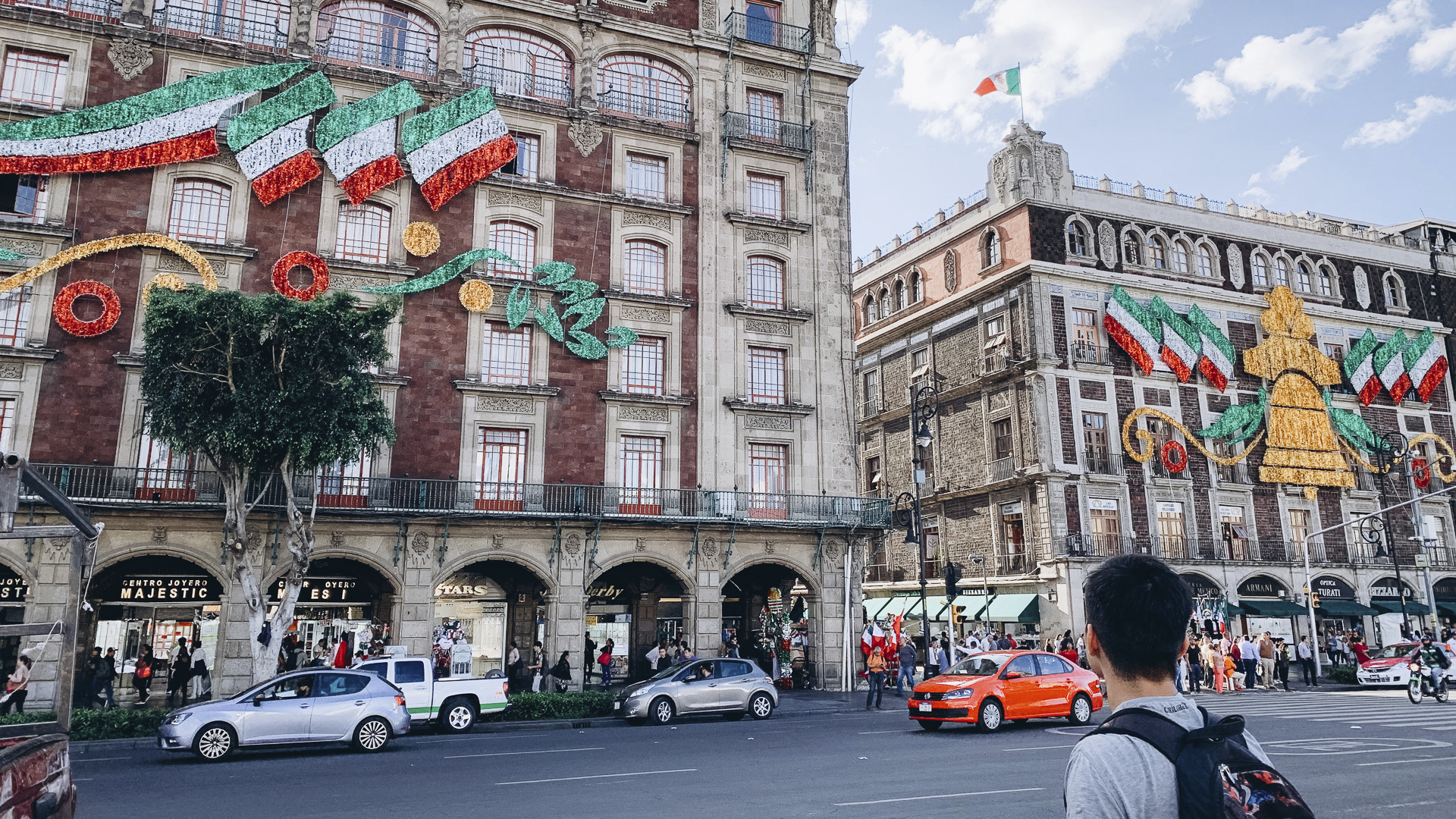
When I was working as an immigration attorney, I heard many horror stories from Central American clients who were kidnapped, trafficked, robbed and raped while crossing through Mexico but who ultimately made it to the United States. Such nightmares were sometimes part of the calculated risk taken by migrants—it is not uncommon for women to receive birth control injections or take other measures to prevent pregnancy by sexual assault during the journey—but were often a shock to those who had heard idealized accounts from friends and family who had successfully arrived.
At the safehouses where Gabriel and his friends stopped along the way, nuns and good Samaritans fed them and tended to their wounds. Gabriel didn’t lose his sense of humor. It’s his exceptional charm and good attitude that I suspect have allowed him to beat the odds to access the support he’s needed.
“One woman wanted us to stay and marry her daughter,” he says. “She said we could apply for papers that way. We said, ‘Nah, we’d rather do that with a gringa—their papers are worth more!’” He crinkles his nose into a smile to show it’s all in good fun.
It was the smoke stain on his face that gave him away, on a bus out of Mexico City. He had huddled too close to the engine on a cold night and although he had scrubbed his skin raw, the marks wouldn’t come off. He had practiced speaking with a Mexican accent to avoid suspicion but when confronted by an official from Migración, he just couldn’t bring himself to lie. At least he didn’t betray his friends; they both made it through while he was taken to an immigration detention center where he was held for ten days.
The choice
Even after the terrors of the journey—and even though he misses his home, holding his sides as he tells me how much he longs for the traditional meal of pupusas with loroco flowers—Gabriel is clear about what he will do if he is sent back to El Salvador. He’ll turn right around and try again for the United States. Indeed, the Red asserts that nearly 30 percent of those migrating to escape violence have been deported in the past, demonstrating that, as Red member Jorge Pérez Cobos put it, “deportation is not the end of an immigration story but merely a setback.” El Salvador is just too dangerous and the US—where Gabriel’s only connections are a distant uncle “who might as well not even be my uncle” and a friend of a friend—seemed like the only place to “get a fresh start.”
Although President Lopez Obrador had promised to take a human rights approach, he quickly agreed to cooperate with President Trump’s demands to curtail migration.
While Gabriel was detained, he was visited by an employee from Mexico’s National System for Integral Family Development (DIF). Since he was still a minor, he qualified for services if he were to apply for asylum in Mexico. (The 2011 Mexican immigration law allows asylum applicants to obtain visitor visas for “humanitarian reasons.”) He didn’t feel like a child anymore: He had left school in the second or third grade, after his father died, and soon after went to work selling water and snacks in downtown San Salvador to help support his family. But he would be held in a shelter instead of being sent directly back to El Salvador. Either way, he would be detained for several days since he was traveling with no identity documents, so he had a little time to think about it.
Gabriel did not initially consider making a good faith effort to obtain asylum in Mexico, but he saw his opportunity. If the authorities kept him here and sent him to a low-security shelter instead of deporting him to El Salvador, he would have a higher likelihood of escaping to continue on his journey. This how he interpreted a recommendation with a wink from the woman from the DIF. He said yes and began plotting his escape. Then his plans changed.
He made friends with volunteers at the shelter. He was assigned a psychologist and an attorney who supported him and gave him hope. He went to classes with the priests and nuns and decided to be baptized. He had been raised with a vague idea of God and spirituality, but no formal religion. He still wasn’t sure if he wanted to identify as Catholic, but the opportunity fit with his broader hope of having a fresh start so he asked his attorney to be his godfather.
As we finish our café con leche, I stop Gabriel and ask why he’s being so open with me. “Am I crazy, or are people in Mexico much more forthcoming than people in El Salvador? I feel like I know more about my Uber driver from earlier this afternoon than about people I’ve known for months in El Salvador, people who have invited me into their homes. Would you have told me all this if we were in El Salvador?”
“No,” he says. “I was shy there. It was my psychologist who explained to me: It’s like you’re carrying all these rocks with you. It’s better if you can lay them down. Besides, in El Salvador, you never know whom the other person knows, or what they want from you. It’s harder to trust.”

The system
In some ways, Gabriel and others in his position would appear to have better luck applying for asylum in Mexico than in the United States, especially now that President Trump has banned almost all asylum-seekers who cross through other countries on the way to the United States and the Supreme Court has (at least temporarily) upheld the ban. Apart from the benefits of a shared language, Mexico has an asylum statute with a broader definition of “refugee” than the US law. In the United States, which uses the definition of “refugee” crafted by the United Nations in 1951, an asylum-seeker must prove that he or she fears persecution on account of race, religion, national origin, political opinion or membership in a particular social group. The persecution leading so many thousands of Salvadorans to flee their country doesn’t neatly fit into any of those categories, defined in the aftermath of World War II.
Mexico, on the other hand, has adopted the updated definition from the 1984 Cartagena Declaration on Refugees. In addition to the 1951 terms, Cartagena also includes “persons who have fled their country because their lives, security or freedom have been threatened by generalized violence, foreign aggression, internal conflicts, a massive violation of human rights or other circumstances which have seriously disturbed public order.” While asylum attorneys in the United States agonize over arguments about how their clients fleeing gang violence have an “imputed anti-gang political opinion” or are members of a particular social group to meet the growing list of requirements laid out by Board of Immigration Appeals, the Mexican asylum law provides alternatives that would include many of the asylum-seekers the US government turns away.
Some 29,623 applications for asylum were filed in Mexico in 2018, a 102 percent increase over 2017 and 236 percent over 2016, according to the Mexican Refugee Aid Commission (COMAR). That number is still a small fraction of the numbers of applications filed in the United States. In 2017 (the most recent year for which the US government has published statistics), over 250,000 people applied for asylum in the US. More than 47,000 of those applications were filed by Salvadorans. El Salvador is the second leading country of nationality of those granted asylum in the United States, after China, but the number of those granted asylum is very low compared to the overall number of applications (in 2017, 3,471 Salvadorans were granted asylum).
Deterrence of Central Americans through increased cooperation between Mexican and US immigration officials began during the Obama administration and has continued to the present day. Although Mexican President Andres Manuel Lopez Obrador—a leftist politician who took office in 2018—had initially promised to take a human rights approach to immigration, he quickly agreed to cooperate with President Trump’s demands to curtail migration. Several of the people I spoke with in Mexico accused him of caving to economic pressure from the United States and abandoning his principles.
In addition to narrowing the definition of “particular social group” in order to exclude common arguments for asylum made by Central Americans and barring asylum-seekers who traveled through another country, the Trump administration has enacted cruel policies at the border, such as separating families and forcing asylum-seekers to remain on the Mexican side of the border while waiting for their court hearings. Apprehensions and deportations of migrants within Mexico have also increased, and the Mexican National Guard has been deployed to provide additional enforcement.

The casa
On my way out of town, I visited Casa Tochán, a nonprofit migrant shelter in the heart of Mexico City. The casa is a tall narrow building sandwiched between two other houses. On the front door, someone has stenciled the words to a “Migrant Prayer” that begins, “My Lord, I am here on my way north. I take with me everything and nothing.” A long-haired young man helped me carry my suitcase up a vertiginous set of stairs to the office, where a volunteer named Betty explained how the resident migrants are referred from other agencies (“They can’t just show up knocking on the door”). She showed me a large ancient-looking spiral notebook that was a hand-written log of all the residents. We were interrupted several times by residents with a variety of issues: the long-haired young man needed a bus pass to go to “Polanco para firmar” (Polanco is the upscale Mexico City neighborhood where the immigration office is located, and from what I understood, the migrants had to check in and “sign” about every two weeks); two more young men came looking for the hair clippers (their makeshift barbershop was on the roof, where one shaved the other’s hair into a stylish cut while others stood around giving commentary); and a tentative young man in a fuchsia dress shirt took a moment to explain what he needed. His halting accent sounded like that of many indigenous Guatemalan clients I worked with in my practice, who speak Spanish as a second language.
“I went today to renew my visa, but they told me I should go back to Acayucan. That’s where my file is. The lady today said she couldn’t help me, that I had to go back there.” Acayucan, in the state of Veracruz, is about a seven-hour drive from Mexico City.
As Betty asked more questions, the young man explained that he had been staying in Coatzacoalcos, about an hour from Acayucan, but had come to Mexico City on the train because the migrant shelter in Coatzacoalcos is under construction, and because there seem to be more opportunities in Mexico City. He did not want to return to Coatzacoalcos because a federal police officer had looked at his visa there, told him the paper was worthless and taken all his money. Betty wrote down his name, saying she would see what she could find out.
After he left the office, she looked at me apologetically and shrugged. “That’s Mexico.”
Before I left, Betty gave me a tour of the facilities. The exterior walls were painted with brightly colored murals showing maps of Mexico and Central America, pro-migrant images and slogans (a painting of the moon with the words in English: “Dreams are not illegal,” and in Spanish: “From here you can’t see borders”), and religious symbols (the Virgin of Guadalupe, Monseñor Oscar Romero, the recently canonized Salvadoran martyr).

The kitchen was locked, as it was not mealtime, but a chore list hung on the door. She explained that although all the food is donated, the shelter manages to serve regular meals. We peeked inside some of the dormitorios, small rooms crammed with bunk beds. As we crossed the courtyard, Betty pointed out some free weights stacked under a shrine to the Virgin of Guadalupe: this was where the residents came to exercise.
In the library, a part-time resident from Honduras sat on the sofa. He had found work as a mechanic a few hours outside the city but still had to come back to firmar every 15 days, so stayed overnight before traveling back to his new home. There had been no space available in the dormitorios so he and some others had slept on air mattresses on the library floor. Like the other residents, he was lucky to have found this space: Of the hundreds of thousands of migrants who travel through Mexico every year, only around 32,000 are registered by the 23 shelters that make up the REDODEM. (In 2018, the Red registered a record-breaking 36,190 people, a 27 percent increase from 2017, but still only a small fraction of the number of total migrants bound for the United States).
An uncertain future
After we finish our coffees, Gabriel and I walk through the Zócalo and he points out where workers are hanging decorations for Mexico’s upcoming Independence Day celebration. A police officer standing by doesn’t blink at the mass jaywalking as we cross against the light with a crowd of other pedestrians. Gabriel playfully punches my arm. “They don’t let you do that in your country, right? You must feel so rebellious!”
As we say good-bye, I wish him luck in his asylum case and ask him to let me know how everything turns out. Although Gabriel is optimistic, his case has already dragged on for much longer than the 45 days within which Mexican law promises a decision. I want to share in his optimism, but I also worry for him. Despite the support of his attorney, his psychologist and our mutual friend, he is still a very young man, alone in a big city with an uncertain future.
Gabriel insists on waiting with me until my Uber comes. It’s getting dark and the tourists are starting to dissipate. Most people are walking with purpose toward some destination, but my attention is drawn to a young family. The woman is seated, holding on to her young toddler who keeps trying to wander off. Mother and daughter have matching hairdos, their long brown hair wrapped in a high bun. Next to them, the father holds out a baseball cap asking for help. His plaintive voice carries over the crowd: “Brothers and sisters, we are from Central America, from Honduras. Please help us, my family has nowhere to spend the night. Brothers and sisters, please help my family, we are migrants.”

